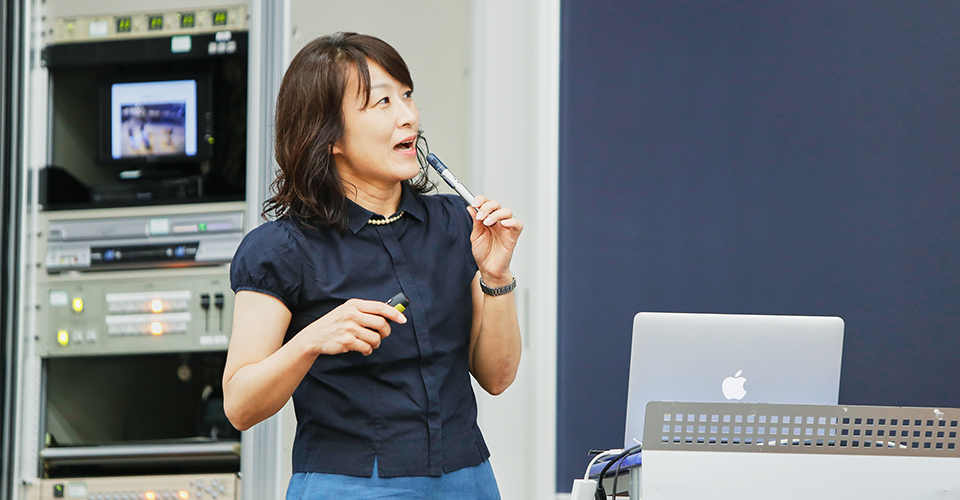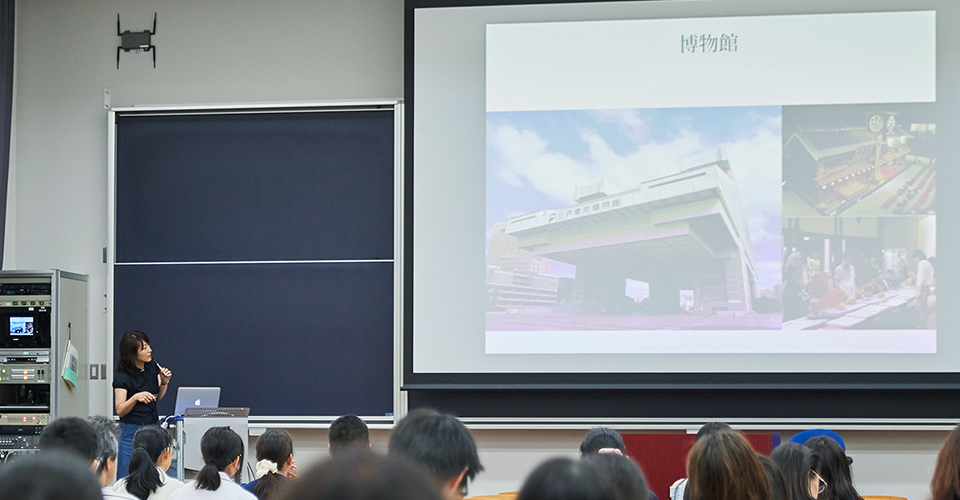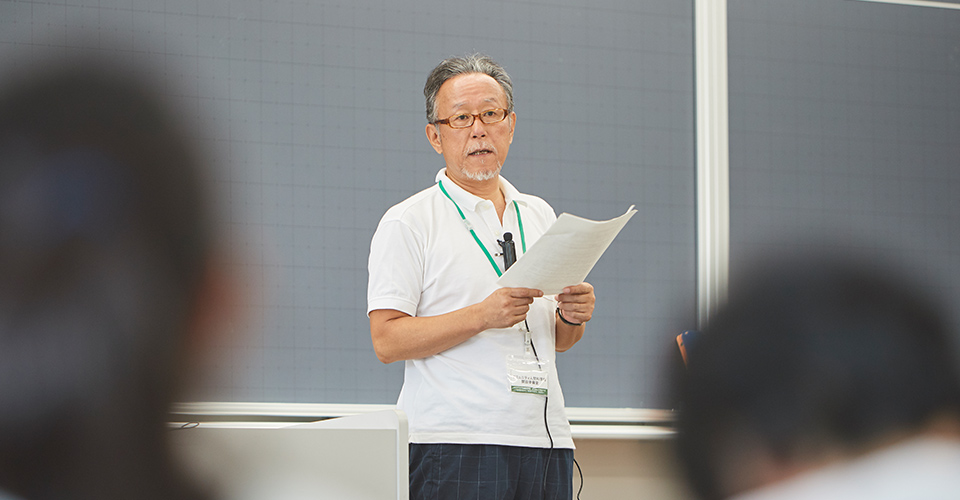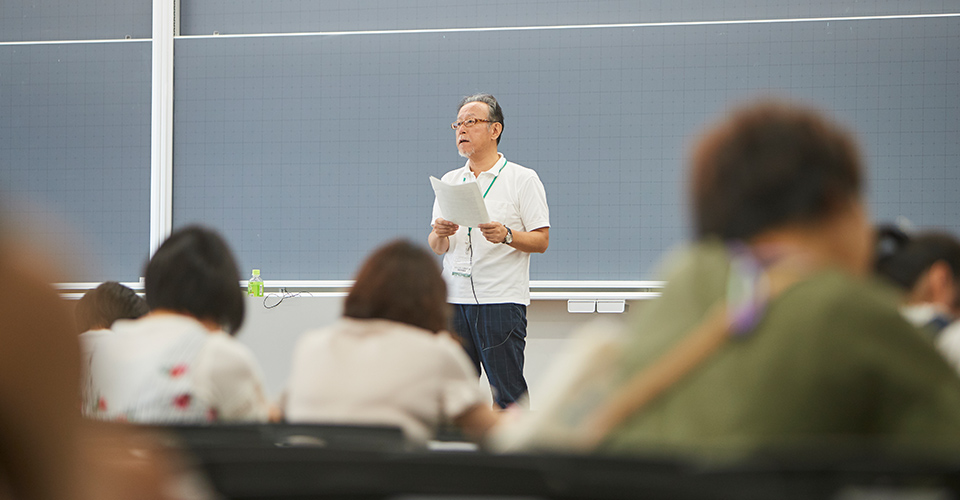- MENU -
LECTURE 模擬授業
-
模擬授業 「コミュニティと計画」
-
コミュニティ人間科学部 紹介ムービー
-
相模原キャンパス 人狼ゲーム形式 キャンパス紹介ムービー
オープンキャンパス模擬授業 「地域の未来と博物館」より
——安斎 聡子 准教授
今日、お話しするのは、地域の中の博物館についてです。皆さんは博物館というと何をイメージするでしょう。たとえば、沖縄県の恩納村博物館では、沖縄ならではの伝統的な暮らしのゾーンがあり、先史時代の海を越えた交流を伝える展示物、沖縄戦での過酷な体験もテーマとなっています。
三重県の四日市市立博物館、ここには、1950年代に四日市市で起きた公害、四日市ぜんそくの概要とそれを克服するために闘い抜いた人々の歴史が紹介されています。長崎県の壱岐市立一支国博物館のテーマは魏志倭人伝に出てくる一支国です。一支国の都と人々の暮らしぶりを大きな模型で再現しています。
このように、博物館ごとにテーマがまったく違うことがわかると思います。でも共通点がひとつあります。それは、「博物館は地域の資料を編集する」ということです。地域が積み重ねてきた歴史や文化、自然環境などにスポットを当てて、もっと意味のあるもの、価値のあるものにリファインしています。
そして、地域の博物館には、さらにもうひとつ「地域の資源を創造する」という働きもあります。三重県鳥羽市の青都とばミュージアムの例です。ここは鳥羽市の商工会議所が主体となって4つの地区をまるごと博物館として捉えて展開している屋外博物館です。その中のひとつ相差(おうさつ)地区は、小さな漁業の町で海女の数の多いことで知られています。
そこで、地元の人たちが、むかし石神さんという信仰があったという記憶を辿り、埋もれていた地域の文化を再生しました。この石神さんは、海女文化と関連した信仰で女性の願いを叶えてくれるパワースポットとして広まり、全国から多くの女性の参拝者を集めています。
これは空想ではなく、そういう信仰が実在したという記憶を再現したものです。ここで重要なのは地域の人たちが自分たちの視点で地域を編集し、創造したということです。
それが人を集めることになれば、経済的な活動も生まれ、地域の活性化にも繋がっていきます。地域の博物館を考えることで、地域の未来を開くことができる。そこに関わる意義は非常に高いと私は思うのです。
オープンキャンパス模擬授業 「多様性とコミュニティ:脱ムラ社会に向けて」より
——齋藤 修三 教授
突然ですが、皆さんには怖いものがありますか? 私たち人間は、同じカテゴリーで群れ(共同体)を作る社会的動物であるが故に、未知な存在や自分とは異質な存在を怖れてしまう傾向があります。
そして怖いと感じてしまう原因のほとんどは、相手側にあるのではなく、こちら側が勝手に思い描くステレオタイプであることが多いのです。
例えば、ハーフと聞くと英語が堪能だと思い込んだり、外国人労働者が増えることで治安を心配したり。でも実際は、事実とカテゴリカルな認識・解釈というのは、必ずしも同じではありません。例えば、行列のできるお店。
日本人の場合、人気店と考えがちですが、海外では、効率の悪い店だと捉える人もいます。つまり、こちら側の思い込みは、きちんとした他者理解に基づいているものではなく、たまたま生まれ育った文化社会というローカルな視点からの共同主観でしかないのです。
周りが信じているから自分もそれに合わせる。そんな昔のムラ社会のような状況が、未だに日本には存在しているのだと思います。しかし、このような判断先行型の無責任な横並び意識になってしまうことは、コミュニティの崩壊、さらには様々な社会問題を招く危険を帯びていると思います。
戦時中、沖縄読谷村では多くの村人がガマ(洞窟)に閉じこもりましたが、歪んだ判断を先行させて米兵を怖れた洞窟では、凄惨な集団自決が行われました。一方、たまたまハワイ帰りの村人がいた洞窟では、パニックに陥った村人をなだめ、米軍と交渉することで、1000人もの命が救われることになりました。
集団が多様性を生かせるかどうか、まさに光と影です。本当に大切なのは、周りが自明視する共同主観に惑わされず、自分で考えきちんと理解することなのです。未知で異質な他者との相互理解を通じて多様性をコミュニティ活性化の糧に変える。そんな包摂力に富んだ理解先行型の外向きコミュニティを創造すること。
これこそ大学の教養であり、コミュニティ人間科学部という新学部に課せられた大きなチャレンジなのではないかと思います。まずは、活力あるコミュニティの創造という目標をみんなで共有し、多様なメンバー同士の緩やかな信頼と協働関係作りから始めましょう。
未知や異質は、狭かった自分の世界を広げてくれる素晴らしい出会いです。皆さんには、相手が誰であれ、きちんと向き合える知的勇気を磨いていただきたいと思います。



